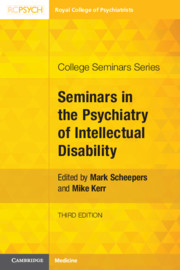Book contents
- Seminars in the Psychiatry of Intellectual Disability
- College Seminars Series
- Seminars in the Psychiatry of Intellectual Disability
- Copyright page
- Contents
- Contributors
- Section 1 Understanding Intellectual Disability
- Chapter 1 Epidemiology of Intellectual Disability
- Chapter 2 Genetics of Intellectual Disability
- Chapter 3 Behavioural Phenotypes
- Chapter 4 Communication in People with Intellectual Disability
- Section 2 Co-morbidity
- Section 3 Psychiatric and Behavioural Disorders
- Section 4 Delivering High-Quality Care
- Index
- References
Chapter 2 - Genetics of Intellectual Disability
from Section 1 - Understanding Intellectual Disability
Published online by Cambridge University Press: 14 January 2019
- Seminars in the Psychiatry of Intellectual Disability
- College Seminars Series
- Seminars in the Psychiatry of Intellectual Disability
- Copyright page
- Contents
- Contributors
- Section 1 Understanding Intellectual Disability
- Chapter 1 Epidemiology of Intellectual Disability
- Chapter 2 Genetics of Intellectual Disability
- Chapter 3 Behavioural Phenotypes
- Chapter 4 Communication in People with Intellectual Disability
- Section 2 Co-morbidity
- Section 3 Psychiatric and Behavioural Disorders
- Section 4 Delivering High-Quality Care
- Index
- References
- Type
- Chapter
- Information
- Seminars in the Psychiatry of Intellectual Disability , pp. 12 - 27Publisher: Cambridge University PressPrint publication year: 2019

